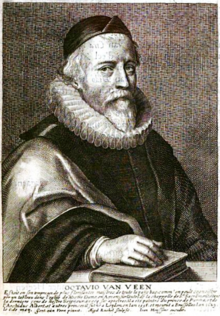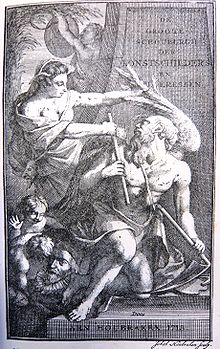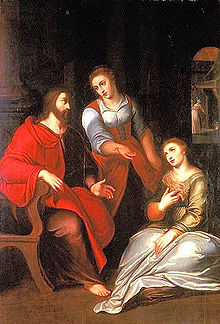- Otto van Veen
-
Otto van Veen 
Ottavio van Veen, in Het Gulden Cabinet p 39Born 1556
LeidenDied 6 May 1629
BrusselsNationality Dutch Field Painting Otto van Veen, also known by his Latinized name Otto Venius or Octavius Vaenius, (Leiden, c. 1556 – Brussels, 6 May 1629) was a painter, draughtsman, and humanist active primarily in Antwerp and Brussels in the late sixteenth and early seventeenth century. He is known for running a large studio in Antwerp, producing several emblem books, and for being, from 1594 or 1595 until 1598, Peter Paul Rubens's teacher. His role as a classically educated humanist artist (a pictor doctus) was influential on the young Rubens, who would take on that role himself.[1]
Contents
Life
 Title print of three volume book Schouburg, by Arnold Houbraken. Houbraken considered Van Veen to be the most impressive artist and scholar of his day and put his portrait (lower left) on his title print.[2]
Title print of three volume book Schouburg, by Arnold Houbraken. Houbraken considered Van Veen to be the most impressive artist and scholar of his day and put his portrait (lower left) on his title print.[2]
Van Veen was born in Leiden around 1556, where his father had been Burgomaster.[3] He probably was a pupil of Isaac Claesz van Swanenburg until October 1572, when the Catholic family moved to Antwerp, and then to Liège. He studied for a time under Dominicus Lampsonius and Jean Ramey, before traveling to Rome around 1574 or 1575. He stayed there for about five years, perhaps studying with Federico Zuccari. Carel van Mander relates that van Veen then worked at the courts of Rudolf II in Prague and William V of Bavaria in Munich, before returning to the Low Countries.[4] In Brussels, he was court painter to the governor of the Southern Netherlands, Alexander Farnese, Duke of Parma until 1592, and then active in Antwerp.
After becoming a master in the Guild of St. Luke in 1593, van Veen took numerous commissions for church decorations, including altarpieces for the Antwerp cathedral and a chapel in the city hall. He also organized his studio and workshop, which included Rubens. Van Veen's connection to Brussels remained, however, and when Archduke Ernest of Austria became governor in 1594, he may have aided the archduke in acquiring important Netherlandish paintings by the likes of Hieronymus Bosch and Pieter Bruegel the Elder.[5] The artist later served as dean in two prominent organizations in the city, the Guild of St. Luke in 1602, and the Romanists in 1606.
In the seventeenth century, van Veen often worked for the Archdukes Albert and Isabella, but never as their court painter.[3] Later paintings include a series of twelve paintings depicting the battles of the Romans and the Batavians,[6] based on engravings he had already published of the subject, for the Dutch States General.[7] Increasingly, van Veen was active in producing Emblem books, including Quinti Horatii Flacci emblemata (1607), Amorum emblemata (1608), and Amoris divini emblemata (1615). His association with humanist culture is reflected in the Latin name by which he is often known, Octavius Vaenius.
He had two brothers who were painters; Gijsbert van Veen (1562-1628) was a respected engraver and Pieter was an amateur.[4] His daughter Gertruid was also a painter.[8]
Notes
- ^ Belkin (1998): 26–28.
- ^ (Dutch) Octavio van Veen biography in De groote schouburgh der Nederlantsche konstschilders en schilderessen (1718) by Arnold Houbraken, courtesy of the Digital library for Dutch literature
- ^ a b Van de Velde.
- ^ a b (Dutch) Octavio van Veen in Karel van Mander's Schilderboeck, 1604, courtesy of the Digital library for Dutch literature
- ^ Bertini (1998): 119.
- ^ Brinio op het schild geheven Painting by Otto van Veen
- ^ Rijksmuseum
- ^ Gertruida van Veen(1602-1643) in the RKD
External links
- Emblem Project Utrecht - 3 editions of emblem books by Otto van Veen
- Vita D. Thomae Aquinatis a manuscript by Otto van Veen (1610)
References
- Belkin, Kristin Lohse: Rubens. Phaidon Press, 1998. ISBN 0-7148-3412-2.
- Bertini, Giuseppe: "Otto van Veen, Cosimo Masi and the Art Market in Antwerp at the End of the Sixteenth Century." Burlington Magazine vol. 140, no. 1139. (Feb. 1998), pp. 119–120.
- Rijksmuseum Amsterdam, Otto van Veen's Batavians defeating the Roman (sic)
- Van de Velde, Carl: "Veen [Vaenius; Venius], Otto van" Grove Art Online. Oxford University Press, [accessed 18 May 2007].
- Entry at the Netherlands Institute for Art History
Categories:- 1550s births
- 1629 deaths
- Mannerist painters
- Flemish Renaissance humanists
- People from Leiden
- Dutch Golden Age painters
- Flemish Baroque painters
- Members of the Antwerp Guild of Saint Luke
- Court painters
Wikimedia Foundation. 2010.

